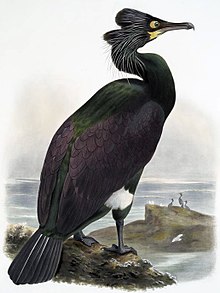Spectacled cormorant
| Spectacled cormorant | |
|---|---|

| |
| Illustration by Joseph Wolf | |
| Scientific classification | |
| Domain: | Eukaryota |
| Kingdom: | Animalia |
| Phylum: | Chordata |
| Class: | Aves |
| Order: | Suliformes |
| Family: | Phalacrocoracidae |
| Genus: | Urile |
| Species: | †U. perspicillatus
|
| Binomial name | |
| †Urile perspicillatus (Pallas, 1811)
| |
| Synonyms | |
| |
The spectacled cormorant or Pallas's cormorant (Urile perspicillatus)[2] is an extinct marine bird of the cormorant family of seabirds that inhabited Bering Island and possibly other places in the Commander Islands and the nearby coast of Kamchatka in the far northeast of Russia.[1] The modern distribution was shown to be a relic of a wider prehistoric distribution in 2018 when fossils of the species from 120,000 years ago were found in Japan. It is the largest species of cormorant known to have existed.[3]
Taxonomy
It was formerly classified in the genus Phalacrocorax, but in 2021, the IOC reclassified it and several other Pacific cormorant species into the genus Urile, based on a 2014 study that supported reclassifying the Brandt's, red-faced, and pelagic cormorants into that genus. Although the spectacled cormorant was not mentioned in the 2014 study and its current taxonomic position is unresolvable by the current phylogenies, it was also reclassified into Urile based on its perceived relatedness to those species.[4][5]
Description
The species was first identified by
With a body mass estimated to be from 3.5 to 6.8 kg (7.7 to 15.0 lb) and a length up to around 100 cm (39 in), the spectacled cormorant was rather larger than all other known cormorants.[7][8] In a similar fashion to the extant flightless cormorant, which may have rivaled it in length but not weight, the spectacled cormorant is thought to have at least largely lost the power of flight which is borne out by the reduced sternum and wing chord of museum specimens.[9][10] This species was largely glossy black in color with a reported greenish gloss that may have been fairly vivid in bright light.
A contrasting large white patch could be seen on its lower flanks just above the legs. Like other cormorants, they had small patches of bare skin about the face including a small gular patch and a small amount of bare skin around the eyes; these areas usually appeared to have been dull-yellow or grayish in hue, but during breeding stages, they may have changed to a bright orangey-reddish hue.[10]
Extinction
Apart from the fact that it fed on fish, almost nothing else is known about the life history of this bird. The population declined quickly after further visitors to the area started collecting the birds for food and feathers. Their reports of profitable whaling grounds and large populations of Arctic foxes and other animals with valuable pelts led to a massive influx of whalers and fur traders into the region; the last birds were reported to have lived around 1850 on Kamen Ariy (Russian: Арий Камень[11]) islet, off the northwestern tip of Bering Island.
A presumed prehistoric record from
See also
- List of extinct birds
- List of extinct animals of Asia
- Steller's sea cow
References
- ^ .
- ^ Phalacrocorax, Ancient Greek word for cormorants (literally "bald raven"). perspicillatus, Latin for "spectacled", in allusion of the birds' large size.
- S2CID 91465582.
- PMID 24994028.
- ^ "Taxonomic Updates – IOC World Bird List". Retrieved 28 July 2021.
- ISBN 0-06-055804-0.
- ^ Hume, J. P., & Walters, M. (2012). Extinct birds (Vol. 217). A&C Black.
- ^ Grzimek, B. (1972). Grzimek's Animal Life Encyclopedia: Birds I-III. Van Nostrand Reinhold Company.
- ^ Roots, C. (2006). Flightless birds. Greenwood Publishing Group.
- ^ a b King, R. J. (2013). The Devil's Cormorant: a Natural History. University of New Hampshire Press.
- ^ Ariy Kamen. Often misspelled "Aji Kamen" or even "Aii Kimur".
- S2CID 88017585.
- S2CID 84570578.

